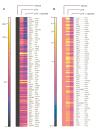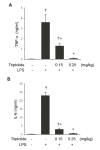Triptolide induces anti-inflammatory cellular responses
- PMID: 19956437
- PMCID: PMC2776323
Triptolide induces anti-inflammatory cellular responses
Abstract
Tripterygium wilfordii Hook F. has been used for centuries in traditional Chinese medicine to treat rheumatoid arthritis, an autoimmune disease associated with increased production of the pro-inflammatory cytokine, tumor necrosis factor (TNF)-alpha. Triptolide is a compound originally purified from T. wilfordii Hook F. and has potent anti-inflammatory and immunosuppressant activities. In this study, we investigated the effect of triptolide on the global gene expression patterns of macrophages treated with lipopolysaccharide (LPS). We found that LPS stimulation resulted in >5-fold increase in expression of 117 genes, and triptolide caused a >50% inhibition in 47 of the LPS-inducible 117 genes. A large portion of the genes that were strongly induced by LPS and significantly inhibited by triptolide were pro-inflammatory cytokine and chemokine genes, including TNF-alpha, IL-1beta, and IL-6. Interestingly, LPS also induced the expression of micro-RNA-155 (miR-155) precursor, BIC, which was inhibited by triptolide. Confirming the cDNA array results, we demonstrated that triptolide blocked the induction of these pro-inflammatory cytokines as well as miR-155 in a dose-dependent manner. Profound inhibition of pro-inflammatory cytokine expression was observed at concentrations as low as 10-50 nM. However, triptolide neither inhibited the phosphorylation or degradation of IkappaBalpha after LPS stimulation, nor affected the DNA-binding activity of NF-kappaB. Surprisingly, we found that triptolide not only inhibited NF-kappaB-regulated reporter transcription, but also dramatically blocked the activity of other transcription factors. Our study offers a plausible explanation of the therapeutic mechanism of T. wilfordii Hook F.
Keywords: Chinese medicine; Inflammation; Tripterygium wilfordii; cytokines; rheumatoid arthritis; transcription.
Figures








Similar articles
-
Triptolide attenuates lipopolysaccharide-induced inflammatory responses in human endothelial cells: involvement of NF-κB pathway.BMC Complement Altern Med. 2019 Aug 2;19(1):198. doi: 10.1186/s12906-019-2616-3. BMC Complement Altern Med. 2019. PMID: 31375092 Free PMC article.
-
Triptolide, a novel diterpenoid triepoxide from Tripterygium wilfordii Hook. f., suppresses the production and gene expression of pro-matrix metalloproteinases 1 and 3 and augments those of tissue inhibitors of metalloproteinases 1 and 2 in human synovial fibroblasts.Arthritis Rheum. 2001 Sep;44(9):2193-200. doi: 10.1002/1529-0131(200109)44:9<2193::aid-art373>3.0.co;2-5. Arthritis Rheum. 2001. PMID: 11592385
-
Triptolide, an active component of the Chinese herbal remedy Tripterygium wilfordii Hook F, inhibits production of nitric oxide by decreasing inducible nitric oxide synthase gene transcription.Arthritis Rheum. 2004 Sep;50(9):2995-303. doi: 10.1002/art.20459. Arthritis Rheum. 2004. PMID: 15457469
-
Triptolide: progress on research in pharmacodynamics and toxicology.J Ethnopharmacol. 2014 Aug 8;155(1):67-79. doi: 10.1016/j.jep.2014.06.006. Epub 2014 Jun 13. J Ethnopharmacol. 2014. PMID: 24933225 Review.
-
Triptolide, a novel immunosuppressive and anti-inflammatory agent purified from a Chinese herb Tripterygium wilfordii Hook F.Leuk Lymphoma. 2001 Jul;42(3):253-65. doi: 10.3109/10428190109064582. Leuk Lymphoma. 2001. PMID: 11699390 Review.
Cited by
-
Identification of triptolide, a natural diterpenoid compound, as an inhibitor of lung inflammation.Am J Physiol Lung Cell Mol Physiol. 2010 Jun;298(6):L830-6. doi: 10.1152/ajplung.00014.2010. Epub 2010 Mar 26. Am J Physiol Lung Cell Mol Physiol. 2010. PMID: 20348278 Free PMC article.
-
Functions and targets of miRNAs in pharmacological and toxicological effects of major components of Tripterygium wilfordii Hook F.Naunyn Schmiedebergs Arch Pharmacol. 2024 Apr;397(4):1997-2019. doi: 10.1007/s00210-023-02764-3. Epub 2023 Oct 13. Naunyn Schmiedebergs Arch Pharmacol. 2024. PMID: 37831113 Review.
-
The effects of triptolide on airway remodelling and transforming growth factor-β₁/Smad signalling pathway in ovalbumin-sensitized mice.Immunology. 2011 Mar;132(3):376-84. doi: 10.1111/j.1365-2567.2010.03392.x. Epub 2011 Jan 7. Immunology. 2011. PMID: 21214541 Free PMC article.
-
Investigation of gene expression profiles in a rat adjuvant arthritis model suggests an effective role of triptolide via PI3K-AKT signaling.Exp Ther Med. 2019 May;17(5):3999-4006. doi: 10.3892/etm.2019.7425. Epub 2019 Mar 20. Exp Ther Med. 2019. PMID: 30988781 Free PMC article.
-
Anti-angiogenic effect of triptolide in rheumatoid arthritis by targeting angiogenic cascade.PLoS One. 2013 Oct 28;8(10):e77513. doi: 10.1371/journal.pone.0077513. eCollection 2013. PLoS One. 2013. PMID: 24204851 Free PMC article.
References
-
- Chen BJ. Triptolide, a novel immunosuppressive and anti-inflammatory agent purified from a Chinese herb Tripterygium wilfordii Hook F. Leuk Lymphoma. 2001;42:253–265. - PubMed
-
- Tao X, Cush JJ, Garret M, Lipsky PE. A phase I study of ethyl acetate extract of the chinese antirheumatic herb Tripterygium wilfordii hook F in rheumatoid arthritis. J Rheumatol. 2001;28:2160–2167. - PubMed
-
- Tao X, Younger J, Fan FZ, Wang B, Lipsky PE. Benefit of an extract of Tripterygium Wilfordii Hook F in patients with rheumatoid arthritis: a double-blind, placebo-controlled study. Arthritis Rheum. 2002;46:1735–1743. - PubMed
-
- Cibere J, Deng Z, Lin Y, Ou R, He Y, Wang Z, Thorne A, Lehman AJ, Tsang IK, Esdaile JM. A randomized double blind, placebo controlled trial of topical Tripterygium wilfordii in rheumatoid arthritis: reanalysis using logistic regression analysis. J Rheumatol. 2003;30:465–467. - PubMed
-
- Qiu D, Kao PN. Immunosuppressive and anti-inflammatory mechanisms of triptolide, the principal active diterpenoid from the Chinese medicinal herb Tripterygium wilfordii Hook. f. Drugs R D. 2003;4:1–18. - PubMed
Grants and funding
LinkOut - more resources
Full Text Sources
